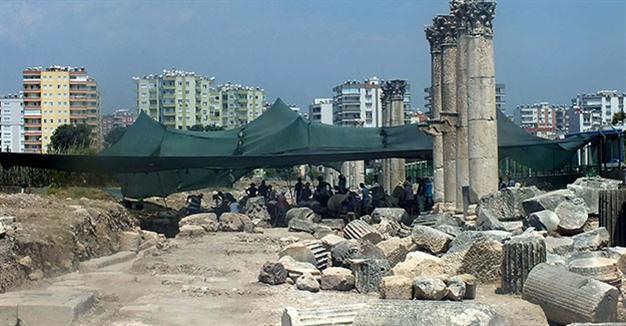Excavations start at Soli Pompeiopolis
MERSİN – Doğan News Agency

DHA photo
Excavation and restoration work has resumed at the 3,000-year-old ancient city of Soli Pompeopolis in the southern city of Mersin’s Mezitli district.The 18th season of excavation works at the site will be headed by Dokuz Eylül University’s Prof. Remzi Yağcı this year. A team of 70 persons, including archaeologists, restorers, survey engineers and students, will work on the ancient city’s columned street, mound field and Roman villa, aiming to reveal the colonization era of the ancient city. The works will continue for 40 days.
Archaeologist Gözdem Güler, who provided information about the works which have been continuing under a huge tent in order to protect the team from excessive warm weather, said, “This year our goal is to find the continuation of the columned street from the Roman era. The findings on this street will shed light on Roman archaeology. We are continuing to reveal the history of the Mediterranean.”
Mezitli Mayor Neşet Tarhan said their goal was to open the ancient city of Soli Pompeiopolis to tourism, adding, “We want to promote the city’s underground beauties to the world. Soli is home to a process from the Hellenistic era to the Roman era. If it receives support, the hidden parts of Cilicia will be revealed and Mersin tourism will be boosted.”
A part of Cilician history
Hundreds of artifacts from 3,000 years ago have been found so far during the excavations in Soli, which was a significant treasure in Cilician history.
Structures like a harbor, columned street, theater, Roman bath, city walls, necropolis and aqueducts have been unearthed.
On the columned street, where the statues of Roman emperors or top officials were situated, excavators found the god of health Asklepeion and goddess Hygeiea, the king of gods Zeus, the god of justice Nemesis, the goddess of the harvest Demeter and the god of wine Dionysus.
Fourteen columns from the 2nd and 3rd centuries in the southern part of the columned street have been revived. In this way, the number of columns increased to 47 on the street.
In the mound, candles, which were gifts to the dead in the ancient ages, and Byzantine-era seals, plates and bowls have been unearthed.
Also among the findings in Soli were 2,500-year-old rock-carved graves that were unearthed during construction works in recent years. A large number of skulls and bones were found in the graves, as well as lubricate and pan lids. These artifacts are on display at the Mersin Museum.
It is believed that Soli, which is home to the Neolithic, Hellenistic and Roman eras, will receive as much attention as Ephesus in western Turkey when the works are finished.
















